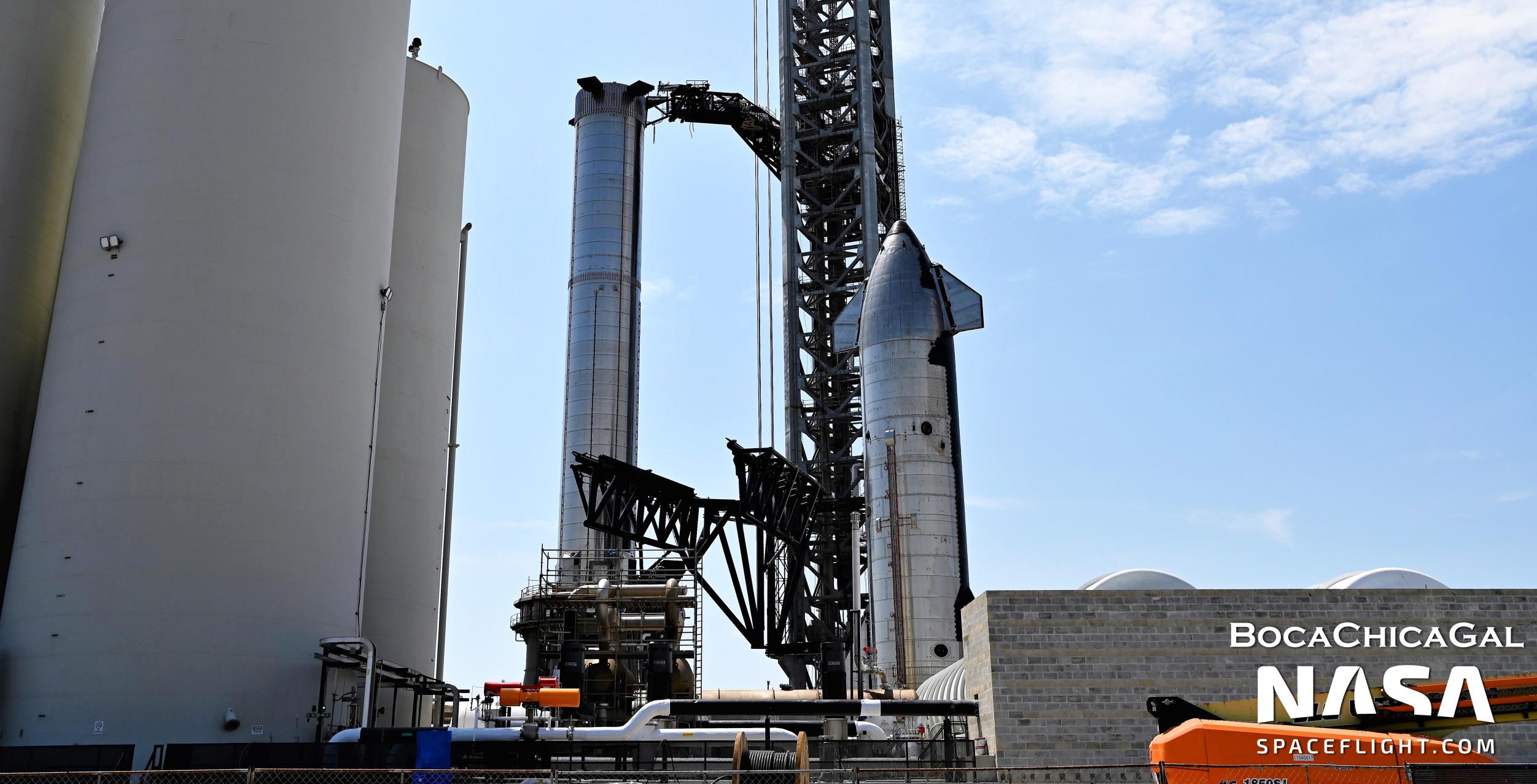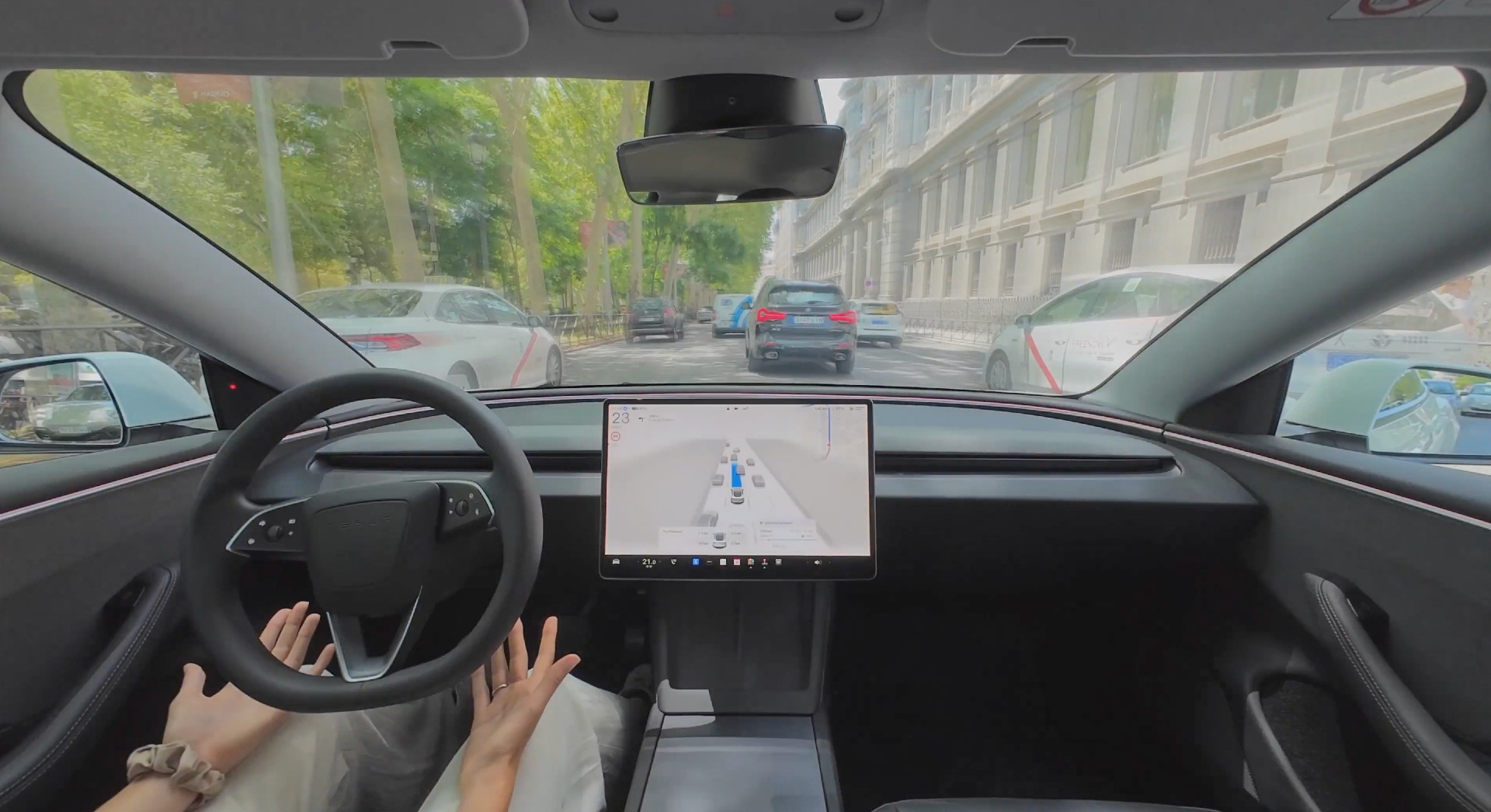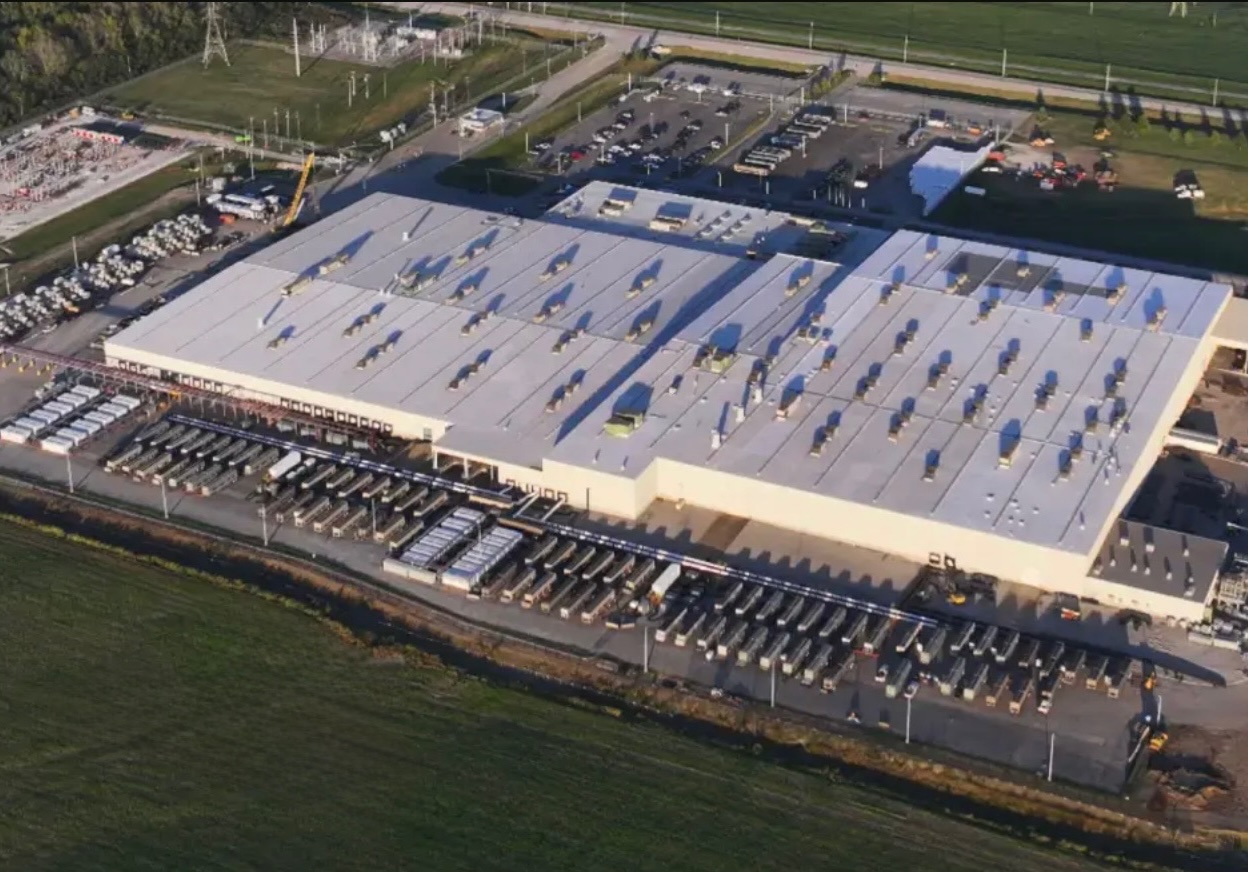

News
SpaceX destacks “420” Starship, Super Heavy pair for the third time
Update: Shortly before SpaceX CEO Elon Musk revealed that Super Heavy booster B4 and Starship S20 are no longer assigned to the rocket’s orbital launch debut, the company ‘destacked’ the pair for the third time.
Ship 20 was removed from Booster 4 on March 19th, two days before Musk’s tweets. That’s not unusual: it was actually Ship 20’s third removal from Super Heavy. However, almost as soon as the Starship was rolled out of the way, SpaceX began making visible preparations to also remove Super Heavy B4 from Starbase’s orbital launch mount. As of March 24th, the booster has been attached to a large crane for more than a day and a newly upgraded transport stand has been rolled into place beside the launch mount. It’s somewhat odd that the booster hasn’t already been removed but that step could happen at almost any moment, now – albeit likely in daylight.
Once both Ship 20 and Booster 4 have been removed, it’s hard to imagine that they will ever return to the orbital launch mount. In fact, at minimum, Super Heavy B4 will probably be retired almost immediately. Super Heavy B7 – a superior, refined, and upgraded prototype by almost every measure – is already almost fully assembled and could likely begin basic testing within a week or two.
SpaceX CEO Elon Musk says that Super Heavy Booster B4 and Starship S20 are no longer scheduled to support the first orbital-class test flight of the world’s largest rocket.
Rumors, signs, and reports of the significant change have been flowing among unofficial spaceflight communities for months. Booster 4 and Ship 20 were first confirmed by Elon Musk to be the pair assigned to Starship’s orbital test flight (OTF) in the summer of 2021. When the pair first rolled out to the launch pad in early August, Musk seemed confident that they could be ready for an orbital launch attempt within a month or two. The same was true in November 2021, when Musk stated that the same Starship and Super Heavy pair could be ready for their first launch as early as January or February 2022.
Musk’s latest update on Starship’s orbital test flight continues that schedule optimism but also introduces several major changes – changes that could easily take several months to fully work through.
Crucially, Musk revealed that the first Starship to attempt an orbital-class launch will now feature upgraded Raptor V2 engines – engines that require an entirely new thrust structure design. That already all but guaranteed that B4 and S20 had been overtaken but Musk also explicitly confirmed that they would be replaced with a new pair in a later tweet.
That new pair – widely assumed to be Super Heavy B7 and Starship S24 – feature a wide range of design changes, including substantially modified header tanks, an entirely new nosecone design, new layouts for secondary systems (pressurization, avionics, heat exchangers, etc.), and more. Most importantly, their thrust structures – giant ‘pucks’ machined out of steel – have been tweaked to support new Raptor V2 engines instead of the Raptor V1 and V1.5 engines that have been installed and tested on all Starship and Super Heavy prototypes to date.
Musk believes that SpaceX will be able to build (and presumably qualify) all 39 of the Raptors Ship 24 and Booster 7 will need before the end of April and fully install them – as well as all the heat shield components that must be fitted around them – by the end of May 2022. It’s unclear if the SpaceX CEO is accounting for the extensive proof testing Ship 24 and Booster 7 will likely need to complete before being qualified for flight, including cryogenic proof tests, wet dress rehearsals, and at least a few static fire tests.
In fact, SpaceX has only performed a single three-engine static fire test with a fully outdated Super Heavy prototype. Before the company is confident in its booster design, it’s practically a certainty that one or more prototypes will be put through a lengthy test campaign that gradually evolves from igniting a few engines to igniting all 29 or 33 Raptors. That may actually be one of the reasons SpaceX appears to be retiring Booster 4 without a single static fire or flight test – performing all the requisite work may have ultimately been perceived as a dead-end when every future Starship and Super Heavy prototype will feature a heavily redesigned engine.
This is to say that much like Musk’s last few Starship OTF schedule estimates, May 2022 also appears to be extremely optimistic. Booster 7 could potentially be ready for cryogenic proof testing any day now but Ship 24 is still in five large pieces and probably at least a month from any form of test readiness. Still, there are some reasons for optimism. If Booster 7 actually does start basic proof testing this month or early next without waiting for its Raptor engines or for heat shield installation, SpaceX could theoretically complete cryoproofing, begin installing one or a few new Raptors at a time, and iteratively progress from static firing a few to all 33 engines as the engines are arriving at Starbase.
At a minimum, even if that razor-sharp test schedule isn’t possible, Booster 7 would at least have a month or so of extra testing over Ship 24, minimizing the disproportionate amount of testing each prototype will likely need to be qualified for flight. Unlike Booster 4, Ship 20 has completed several static fires and cryoproofs without any apparent issue.
For now, SpaceX continues to prepare Ship 24 sections for stacking and appears to be buttoning up Booster 7, which could easily be ready to roll out for basic testing within a few weeks – and maybe sooner.
Elon Musk
Why Tesla’s Q3 could be one of its biggest quarters in history
Tesla could stand to benefit from the removal of the $7,500 EV tax credit at the end of Q3.

Tesla has gotten off to a slow start in 2025, as the first half of the year has not been one to remember from a delivery perspective.
However, Q3 could end up being one of the best the company has had in history, with the United States potentially being a major contributor to what might reverse a slow start to the year.
Earlier today, the United States’ House of Representatives officially passed President Trump’s “Big Beautiful Bill,” after it made its way through the Senate earlier this week. The bill will head to President Trump, as he looks to sign it before his July 4 deadline.
The Bill will effectively bring closure to the $7,500 EV tax credit, which will end on September 30, 2025. This means, over the next three months in the United States, those who are looking to buy an EV will have their last chance to take advantage of the credit. EVs will then be, for most people, $7,500 more expensive, in essence.
The tax credit is available to any single filer who makes under $150,000 per year, $225,000 a year to a head of household, and $300,000 to couples filing jointly.
Ending the tax credit was expected with the Trump administration, as his policies have leaned significantly toward reliance on fossil fuels, ending what he calls an “EV mandate.” He has used this phrase several times in disagreements with Tesla CEO Elon Musk.
Nevertheless, those who have been on the fence about buying a Tesla, or any EV, for that matter, will have some decisions to make in the next three months. While all companies will stand to benefit from this time crunch, Tesla could be the true winner because of its sheer volume.
If things are done correctly, meaning if Tesla can also offer incentives like 0% APR, special pricing on leasing or financing, or other advantages (like free Red, White, and Blue for a short period of time in celebration of Independence Day), it could see some real volume in sales this quarter.
You can now buy a Tesla in Red, White, and Blue for free until July 14 https://t.co/iAwhaRFOH0
— TESLARATI (@Teslarati) July 3, 2025
Tesla is just a shade under 721,000 deliveries for the year, so it’s on pace for roughly 1.4 million for 2025. This would be a decrease from the 1.8 million cars it delivered in each of the last two years. Traditionally, the second half of the year has produced Tesla’s strongest quarters. Its top three quarters in terms of deliveries are Q4 2024 with 495,570 vehicles, Q4 2023 with 484,507 vehicles, and Q3 2024 with 462,890 vehicles.
Elon Musk
Tesla Full Self-Driving testing continues European expansion: here’s where
Tesla has launched Full Self-Driving testing in a fifth European country ahead of its launch.

Tesla Full Self-Driving is being tested in several countries across Europe as the company prepares to launch its driver assistance suite on the continent.
The company is still working through the regulatory hurdles with the European Union. They are plentiful and difficult to navigate, but Tesla is still making progress as its testing of FSD continues to expand.
Today, it officially began testing in a new country, as more regions open their doors to Tesla. Many owners and potential customers in Europe are awaiting its launch.
On Thursday, Tesla officially confirmed that Full Self-Driving testing is underway in Spain, as the company shared an extensive video of a trip through the streets of Madrid:
Como pez en el agua …
FSD Supervised testing in Madrid, Spain
Pending regulatory approval pic.twitter.com/txTgoWseuA
— Tesla Europe & Middle East (@teslaeurope) July 3, 2025
The launch of Full Self-Driving testing in Spain marks the fifth country in which Tesla has started assessing the suite’s performance in the European market.
Across the past several months, Tesla has been expanding the scope of countries where Full Self-Driving is being tested. It has already made it to Italy, France, the Netherlands, and Germany previously.
Tesla has already filed applications to have Full Self-Driving (Supervised) launched across the European Union, but CEO Elon Musk has indicated that this particular step has been the delay in the official launch of the suite thus far.
In mid-June, Musk revealed the frustrations Tesla has felt during its efforts to launch its Full Self-Driving (Supervised) suite in Europe, stating that the holdup can be attributed to authorities in various countries, as well as the EU as a whole:
Tesla Full Self-Driving’s European launch frustrations revealed by Elon Musk
“Waiting for Dutch authorities and then the EU to approve. Very frustrating and hurts the safety of people in Europe, as driving with advanced Autopilot on results in four times fewer injuries! Please ask your governing authorities to accelerate making Tesla safer in Europe.”
Waiting for Dutch authorities and then the EU to approve.
Very frustrating and hurts the safety of people in Europe, as driving with advanced Autopilot on results in four times fewer injuries!
Please ask your governing authorities to accelerate making Tesla safer in Europe. https://t.co/QIYCXhhaQp
— Elon Musk (@elonmusk) June 11, 2025
Tesla said last year that it planned to launch Full Self-Driving in Europe in 2025.
Elon Musk
xAI’s Memphis data center receives air permit despite community criticism
xAI welcomed the development in a post on its official xAI Memphis account on X.

Elon Musk’s artificial intelligence startup xAI has secured an air permit from Memphis health officials for its data center project, despite critics’ opposition and pending legal action. The Shelby County Health Department approved the permit this week, allowing xAI to operate 15 mobile gas turbines at its facility.
Air permit granted
The air permit comes after months of protests from Memphis residents and environmental justice advocates, who alleged that xAI violated the Clean Air Act by operating gas turbines without prior approval, as per a report from WIRED.
The Southern Environmental Law Center (SELC) and the NAACP has claimed that xAI installed dozens of gas turbines at its new data campus without acquiring the mandatory Prevention of Significant Deterioration (PSD) permit required for large-scale emission sources.
Local officials previously stated the turbines were considered “temporary” and thus not subject to stricter permitting. xAI applied for an air permit in January 2025, and in June, Memphis Mayor Paul Young acknowledged that the company was operating 21 turbines. SELC, however, has claimed that aerial footage shows the number may be as high as 35.
Critics are not giving up
Civil rights groups have stated that they intend to move forward with legal action. “xAI’s decision to install and operate dozens of polluting gas turbines without any permits or public oversight is a clear violation of the Clean Air Act,” said Patrick Anderson, senior attorney at SELC.
“Over the last year, these turbines have pumped out pollution that threatens the health of Memphis families. This notice paves the way for a lawsuit that can hold xAI accountable for its unlawful refusal to get permits for its gas turbines,” he added.
Sharon Wilson, a certified optical gas imaging thermographer, also described the emissions cloud in Memphis as notable. “I expected to see the typical power plant type of pollution that I see. What I saw was way worse than what I expected,” she said.
-

 Elon Musk3 days ago
Elon Musk3 days agoTesla investors will be shocked by Jim Cramer’s latest assessment
-

 News1 week ago
News1 week agoTesla Robotaxi’s biggest challenge seems to be this one thing
-

 News2 weeks ago
News2 weeks agoTexas lawmakers urge Tesla to delay Austin robotaxi launch to September
-

 Elon Musk2 weeks ago
Elon Musk2 weeks agoFirst Look at Tesla’s Robotaxi App: features, design, and more
-

 Elon Musk2 weeks ago
Elon Musk2 weeks agoxAI’s Grok 3 partners with Oracle Cloud for corporate AI innovation
-

 News2 weeks ago
News2 weeks agoWatch Tesla’s first driverless public Robotaxi rides in Texas
-

 News2 weeks ago
News2 weeks agoSpaceX and Elon Musk share insights on Starship Ship 36’s RUD
-

 News2 weeks ago
News2 weeks agoTesla has started rolling out initial round of Robotaxi invites














